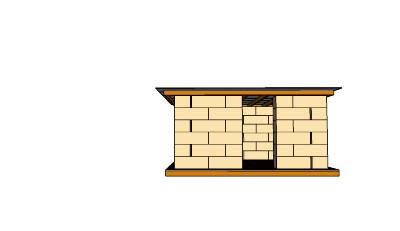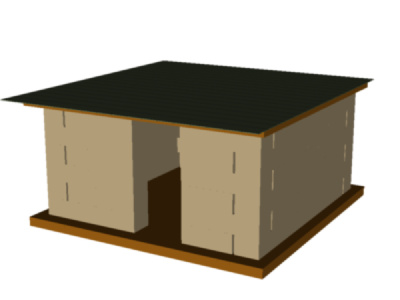Temporary Hay House: Difference between revisions
Jump to navigation
Jump to search
Margaret Ida (talk | contribs) |
Margaret Ida (talk | contribs) (→Design) |
||
| Line 3: | Line 3: | ||
*It is quickly constructed. | *It is quickly constructed. | ||
*It uses components already on site. | *It uses components already on site. | ||
* | *It is intended to be dismantled and its components incorporated in finishing another building project. | ||
[[File:Hay Bale Shelter.jpg|left]] | [[File:Hay Bale Shelter.jpg|left]] | ||
[[File:3-D model.jpg|center]] | [[File:3-D model.jpg|center]] | ||
*The base is a 16'x16' prebuilt roof frame. | |||
*The flooring is 2"x6"x16' dimensional lumber. | |||
*The walls are stacked haybales. | |||
*The roof is another 16'x16' roof frame covered with steel barn-roof panels | |||
=Components= | =Components= | ||
Revision as of 18:42, 7 October 2011
Design
This little house is designed solely as a temporary shelter.
- It is quickly constructed.
- It uses components already on site.
- It is intended to be dismantled and its components incorporated in finishing another building project.
- The base is a 16'x16' prebuilt roof frame.
- The flooring is 2"x6"x16' dimensional lumber.
- The walls are stacked haybales.
- The roof is another 16'x16' roof frame covered with steel barn-roof panels
Components
- 3 16'x16' prebuilt roof frames
- 37 2"x6"x16' beams
- 74 3" screws
- 115 hay bales (about 14"x18"x4')
- 10 3'x17' barn roof panels
Building these modular roof frames is described in instructions for the Workshop and the Hab Lab. Hay is cut and baled on the farm - in this case planned for use as wall insulation for the Hab Lab. A stack of roof panels was on site already, in anticipation of their use to finish the Hab Lab and Workshop roofs.

